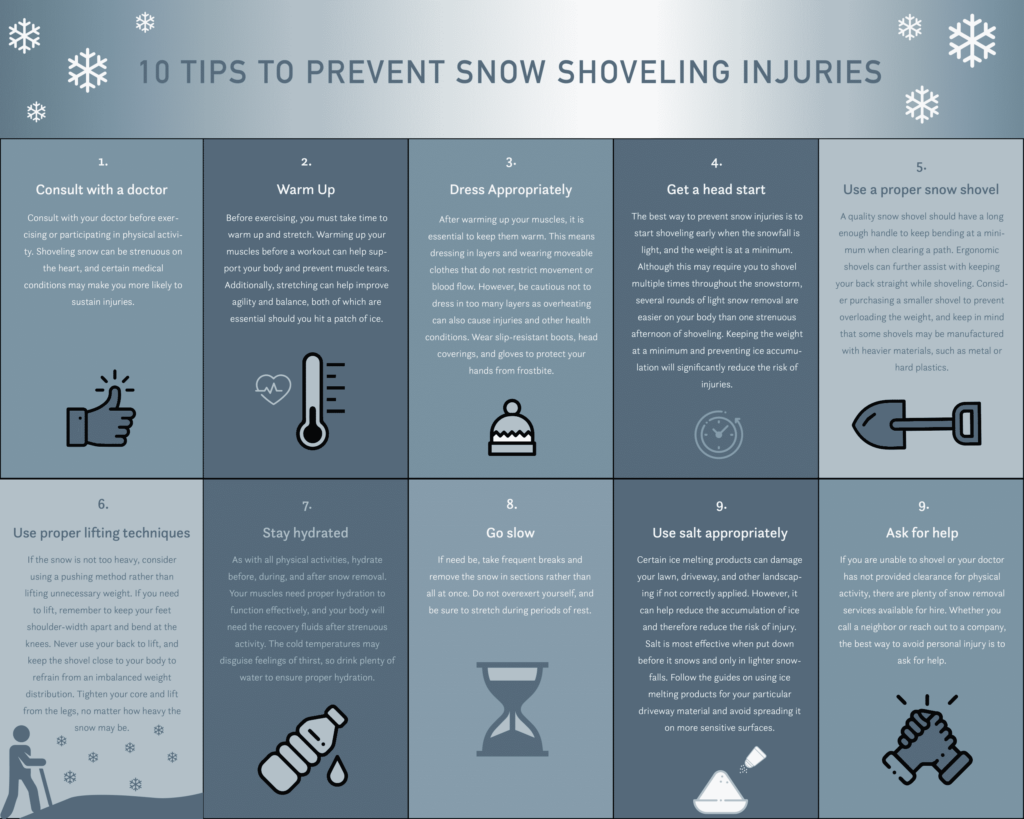While snow may be beautiful to enjoy over the holidays, winter can present serious inconveniences for families across the country. Especially for those living in the northeastern United States, including Massachusetts, Rhode Island, and New Hampshire, snow may accumulate faster and with greater density than other regions. With enough snowfall, residents may experience traffic delays, car accidents, pedestrian injuries, and even property damage. Therefore, snow removal plays a vital role in protecting your home and your loved ones from potential risks.
Depending on the amount of snowfall, shoveling your driveway may not be an enormous undertaking. However, ice and freezing temperatures can quickly make the job more demanding. Understanding safety precautions before shoveling can prevent injuries and avoid an expected trip to the hospital.
What are the dangers of snow removal?
Although snow itself is not usually heavy, shoveling it in large quantities can be challenging if you are not physically in shape. Unlike going to the gym, many people don’t view snow removal as a form of exercise, so it is uncommon for individuals to warm up properly before heading outside. However, shoveling snow is a form of physical exertion as it can often require strength, agility, and balance. Additionally, snow removal can be hard on your cardiovascular system and can even result in a heart attack.
Cold weather tends to elevate the heart rate and raise blood pressure, putting even young and healthy individuals at risk for cardiac arrest. Particularly if your body is more familiar with a sedentary lifestyle, the sudden exertion of snow shoveling can put a significant strain on your heart. Additionally, pushing a heavy snow blower can also present risks of injury. This is why homeowners must take the right precautions and know how to remove snow safely.
Tips to prevent snow shoveling injuries

Consult with a doctor
Consult with your doctor before exercising or participating in physical activity. Shoveling snow can be strenuous on the heart, and certain medical conditions may make you more likely to sustain injuries.
Warm up
Before exercising, you must take time to warm up and stretch. Warming up your muscles before a workout can help support your body and prevent muscle tears. Additionally, stretching can help improve agility and balance, both of which are essential should you hit a patch of ice.
Dress appropriately
After warming up your muscles, it is essential to keep them warm. This means dressing in layers and wearing moveable clothes that do not restrict movement or blood flow. However, be cautious not to dress in too many layers as overheating can also cause injuries and other health conditions. Wear slip-resistant boots, head coverings, and gloves to protect your hands from frostbite.
Get a head start
The best way to prevent snow injuries is to start shoveling early when the snowfall is light, and the weight is at a minimum. Although this may require you to shovel multiple times throughout the snowstorm, several rounds of light snow removal are easier on your body than one strenuous afternoon of shoveling. Keeping the weight at a minimum and preventing ice accumulation will significantly reduce the risk of injuries.
Use a proper snow shovel
A quality snow shovel should have a long enough handle to keep bending at a minimum when clearing a path. Ergonomic shovels can further assist with keeping your back straight while shoveling. Consider purchasing a smaller shovel to prevent overloading the weight, and keep in mind that some shovels may be manufactured with heavier materials, such as metal or hard plastics.
Use proper lifting techniques
If the snow is not too heavy, consider using a pushing method rather than lifting unnecessary weight. If you need to lift, remember to keep your feet shoulder-width apart and bend at the knees. Never use your back to lift, and keep the shovel close to your body to refrain from an imbalanced weight distribution. Tighten your core and lift from the legs, no matter how heavy the snow may be.
Stay hydrated
As with all physical activities, hydrate before, during, and after snow removal. Your muscles need proper hydration to function effectively, and your body will need the recovery fluids after strenuous activity. The cold temperatures may disguise feelings of thirst, so drink plenty of water to ensure proper hydration.
Go slow
If need be, take frequent breaks and remove the snow in sections rather than all at once. Do not overexert yourself, and be sure to stretch during periods of rest.
Use salt appropriately
Certain ice melting products can damage your lawn, driveway, and other landscaping if not correctly applied. However, it can help reduce the accumulation of ice and therefore reduce the risk of injury. Salt is most effective when put down before it snows and only in lighter snowfalls. Follow the guides on using ice melting products for your particular driveway material and avoid spreading it on more sensitive surfaces.
Ask for help
If you are unable to shovel or your doctor has not provided clearance for physical activity, there are plenty of snow removal services available for hire. Whether you call a neighbor or reach out to a company, the best way to avoid personal injury is to ask for help.
Learn more about our snow shoveling tips, using the right technique for snow removal and ice management will help ensure you stay safe.
